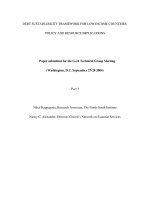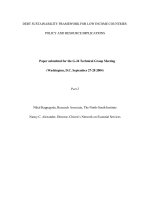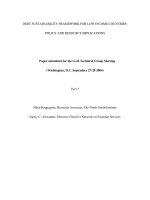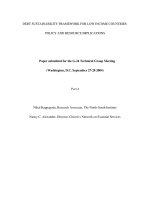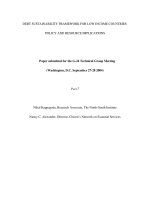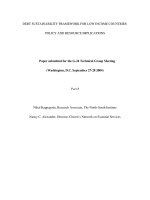DEBT SUSTAINABILITY FRAMEWORK FOR LOW INCOME COUNTRIES : POLICY AND RESOURCE IMPLICATIONS - Part 1
Bạn đang xem bản rút gọn của tài liệu. Xem và tải ngay bản đầy đủ của tài liệu tại đây (27.97 KB, 10 trang )
DEBT SUSTAINABILITY FRAMEWORK FOR LOW INCOME COUNTRIES:
POLICY AND RESOURCE IMPLICATIONS
Paper submitted for the G-24 Technical Group Meeting
(Washington, D.C. September 27-28 2004)
Part 1
Nihal Kappagoda, Research Associate, The North-South Institute
Nancy C. Alexander, Director, Citizen’s Network on Essential Services
CONTENTS
Executive Summary
Introduction 1
Debt Sustainability and Debt Indicators 2
Debt Sustainability Framework 6
Debt Distress 7
Performance Based Allocation System 10
Allocation of Grants 14
Financing of Grants 15
Concerns and Issues 16
Debt Sustainability Framework 16
The PBA System 17
Other Issues 18
Conclusions and Recommendations
18
CPIA 20
Debt Thresholds and Indicators 21
Annexes
1. Debt Indicators 23
2. Country Performance Ratings for 2003 25
3. List of References
32
ABBREVIATIONS
CPIA Country Policy and Institutional Assessment
DSA Debt Sustainability Analysis
DSF Debt Sustainability Framework
GDP Gross Domestic Product
GNI Gross National Income
HIPC Highly Indebted Poor Countries
IDA International Development Association
ICP IDA Country Performance
IMF International Monetary Fund
IFI International Financial Institution
MDG Millennium Development Goal
PBA Performance Based Allocation
PNG Private Non Guaranteed
PV Present Value
EXECUTIVE SUMMARY
The Debt Sustainability Framework sets out a proposal by the World Bank
for identifying countries in actual or potential debt distress situations
leading to a formula for determining grant eligibility within the amounts to
be allocated during the Fourteenth Replenishment of IDA. It attempts to
classify countries based on the performance of their institutions and policies
and determine thresholds for selected debt indicators for each country
grouping and then estimate the level of debt distress as measured by the
forecast levels of the selected indicators from the country DSAs. This leads
to a formula for determining grant eligibility within the IDA allocation
made on the basis of the Performance Based Allocation System that uses
the Country Policy and Institutional Assessment and governance rating of
the country concerned. The increase in grants has implications for the
future of IDA funding which also needs consideration.
Although called the Debt Sustainability Framework it does not provide a
mechanism to ensure that bilateral and other multilateral donors will act in
accord with IDA in their lending so that low income countries could reduce
their debt vulnerability. This is particularly important when IDA accounts
for only a small share of a country’s external borrowing. It also begs the
question about action that should be taken about current high levels of debt
stock. Effective donor coordination will be necessary to achieve debt
sustainability which is the objective of the new allocation system. The
international community needs to address this issue at the time the DSF is
approved in the same way that it was done when the HIPC Initiative was
launched.
There are differences between the HIPC Initiative and the DSF. The former
was intended to deal with the debt overhang brought about by past
borrowing, while the Framework is intended to reduce the accumulation of
future debts of low income countries to unsustainable levels. While the
HIPC Initiative used a single indicator, that is the ratio of debt to exports to
judge sustainability the DSF selects three debt ratios which are the present
value of public and publicly guaranteed external debt to gross domestic
product and to exports, and debt service on the same debt to exports to
judge debt sustainability. Country policies and institutional capability and
vulnerability to shocks are other factors identified as being important for
assessing a country’s debt sustainability.
The DSF uses the Country Policy and Institutional Assessments done for
each borrowing country to classify countries by performance and determine
different debt ratio thresholds for the selected indicators. The allocations
under IDA 14 will be based on the Performance Based Allocation System
